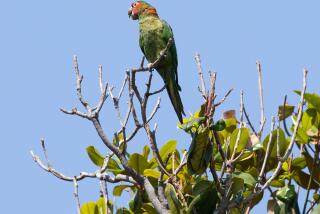Homing In on the Competition : A Swoop and a Holler Sound Victory for Area’s Top Pigeon Racers
- Share via
Philip Adsit sits in his back yard in Downey, waiting for his beloved homing pigeons to return.
His 12-bird team was released only hours earlier in Modesto at the start of a 302-mile race against about 700 other Southeast-area pigeons.
Just as Adsit, 69, looks up, one of his “athletes of the sky” cuts through the wind and starts circling the yard.
“Here comes a bird!” he exclaims. “Come on, come on!”
The pigeon swoops down, landing gracefully on a coop. After a short pause, the animal flutters to its indoor nest without even stopping for water.
It’s pigeon racing season in the Southeast area, and clubs in Compton, Montebello, Norwalk and Bellflower are sponsoring races that span hundreds of miles and award trainers with prize money, trophies and bragging rights.
“What I really love is when one of these birds comes home,” said Verna Adsit, Philip’s wife. “To see it just gives you goose bumps.”
Homing pigeons use internal compasses to guide their return flights from up to 1,000 miles away. Best known as historical messengers, the birds in ancient Greece were sent home with race results from far-off competitions. In World War II, the Allies used the birds to relay information from behind enemy lines.
The creatures fly at about 60 miles per hour, but can reach 80 miles per hour in high winds. The Adsits’ charges made the flight from Modesto in four to six hours, reaching speeds in the high 70s. One bird placed second, winning a certificate.
In the Southeast area, there are about 1,000 registered pigeons, 120 trainers and six clubs. Founded in the 1930s, the 36-member Compton Homing Pigeon Club is the area’s oldest. “It’s the only place (in the Southeast area) that has a clubhouse,” said Compton club member Dick Crawford, 74, of Long Beach. “And we built it ourselves.”
Racing pigeons is costly. A top local bird fetches about $3,000, while those on the national circuit can sell for $10,000. Then there’s the cost of feed, coops and club dues.
Having won several hundred races, the Adsits, who belong to a club in Montebello, are considered premier local trainers. They own about 100 birds and run a breeding program.
The couple say their mutual passion for the denizens of the air does wonders for their marriage of 47 years. Both started training pigeons as children.
“A lot of women complain about the birds because they take up too much time, but I know where my husband is,” Verna Adsit, 67, said. “He’s not at the bowling alley or with some floozy, he’s with the birds in the back yard.”
Not everyone shares an affection for the creatures. Several squabbles that started across backyard fences have made their way to area city halls in recent years.
Until a few weeks ago, Downey prohibited residents from keeping more than five pigeons. The city Planning Commission and City Council agreed to review the ordinance after city code inspectors received an anonymous letter complaining that one resident was keeping 75 birds.
After hearing arguments from enthusiasts as well as opponents, who complained of droppings, noise and odors, the council revised the law to allow residents to keep up to 100 birds.
The Adsits said they were able to keep their birds for several years before the law was changed because neighbors did not complain to the city.
Ron Yoshiki, Downey’s assistant director of community development, said owners must keep cages clean, control noise levels and obtain licenses. Yoshiki said he was assured by trainers that the birds usually fly on empty stomachs so droppings are rarely a problem.
*
Pico Rivera relaxed its codes in 1993 to allow residents an unlimited number of birds. Whittier decided in 1992 to allow residents to keep 100 birds after inspectors threatened to confiscate one man’s flock. Long Beach does not limit the number of pigeons, but requires residents to obtain a health department permit. Cerritos has no restrictions.
Other cities, such as La Mirada and Montebello, have strict regulations. La Mirada will allow a total of five pigeons, said Andrea Travis, a community development officer.
Montebello permits five birds, but allows more if a resident can get a Planning Commission permit.
Eric Hughes, a county veterinarian, said the pigeons can spread disease to humans. “Any time you have litter building up, you have health problems,” he said. But he added that health risks are low if the birds’ quarters are kept clean.
More to Read
Sign up for Essential California
The most important California stories and recommendations in your inbox every morning.
You may occasionally receive promotional content from the Los Angeles Times.













